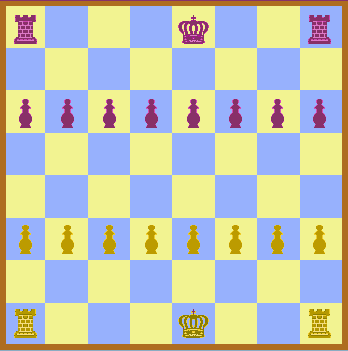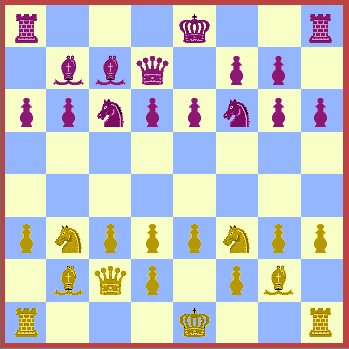
Introduction
A great barrier in orthodox chess is opening knowledge. To attain a respectable level of play is impossible without extensive and time-consuming opening studies. Time and again amateurs go astray in the opening, and the positions reached are awkward. This could make chess a frustrating experience. On the other hand, at professional level, chess is deteriorating on account of too much opening knowledge, aided by computers. The combative aspect is quenched. Swedish Chess presents a solution, in that it’s now possible to attain tenable and interesting middlegame positions without burying oneself in opening studies.
The objective in Swedish Drop Chess is checkmate. Pieces move as in orthodox chess. The pawns also move as in orthodox chess, but have no initial double move. As the pawns are all located on the third rank, they can reach the fourth rank immediately anyway. Castling is allowed. Promotion rules are the same as in orthodox chess. In the first phase the players take turns to drop pieces on the board, either behind the pawn chain, or on a friendly pawn. In the latter case the removed friendly pawn must immediately be relocated to another empty position, that is, somewhere on the second rank. The two bishops must be dropped on different colours. Moreover, they cannot be dropped on the third rank. (This is to prevent early piece exchanges.) The King and Rooks are initially placed on their standard positions. They are immobile until all pieces have been dropped. After all the pieces have been dropped the play begins.
Swedish Drop Chess is inspired by Burmese Chess. It was designed to solve the problem of opening monotony in orthodox chess. In Swedish Chess the en passant capture and the pawn’s double step are redundant. It was invented and implemented by undersigned, April 2006. The name comes from the fact that the inventor is Swedish.
You should give your King a protected position by castling. You can relocate the pawns so that they protect the King. If the King is placed on the opposite wing as the enemy King then the game is likely to be combative. If the King is placed on the same wing as the opponent, then the game is more likely to be positional, that is, more peaceful. Remember that relocated pawns on the second rank have no initial double move, so it takes longer to activate such pawns. In the opening phase, the same pawn can be relocated several times, by dropping pieces on it. Keep the pawns in the centre, because center pawns are valuable.
In an alternative variant all pieces, except pawns, are exterior. In this case castling isn’t allowed, and the Rooks must be dropped on the first rank.
 The dropping phase is finished. Pieces have been placed on good squares and one pawn has been relocated to protect the king. Now white can begin play with d3-d4, for instance.
The dropping phase is finished. Pieces have been placed on good squares and one pawn has been relocated to protect the king. Now white can begin play with d3-d4, for instance.
Discussion
Orthodox chess (Fide-chess) is today more and more revolving around computer-aided opening preparation. The game is increasingly taking place before the actual meeting at the chessboard, by the meticulous preparation against an opponent and his particular repertoire. The science of openings is becoming a heavy burden to grandmaster and amateur alike. The slavish iteration of concrete opening variations is depleting the combative aspect of chess. Is chess becoming a game for memory artists? Today a grandmaster must always labour at home to prepare against an opponent’s preparations against the grandmaster’s own favourite openings.
This is probably why many grandmasters advocate shorter time limits, and more than one round per day. In this way the combative aspect of chess is promoted and the scientific aspect is lessened. The disadvantage is that the quality of the games will suffer.
Fischer Random Chess was designed to answer the problem of opening monotony. But as opening studies are virtually meaningless in FischeRandom, this form of chess risks becoming a display of chess technique. In fact, chess players take great pleasure in developing their own secret variations. They study openings with a scientific method. As opening and middle game connect, these studies are important for a deepened understanding of the game.
Swedish Drop Chess is an interesting alternative. It meets the requirement that the players can develop and study their own favourite systems. But here it is more a matter of principles than of concrete variations. The kings are likely to end up on different wings, which vouches for combative play. As some of the pawns will be relocated to the second rank, the positions will be quite similar to those occuring in orthodox chess, and chessplayers will feel quite at home. The opening phase is, from a strategical point of view, very interesting. Unlike normal chess, there is no way for white to steer the game into drawish variations.
• You can download my free Swedish Drop Chess program here, (updated 2017-07-01) but you must own the software Zillions of Games to be able to run it.
• Try playing Swedish Drop Chess by e-mail, against a human opponent, here.
• Don’t miss my other chess variants.
© M. Winther 2006